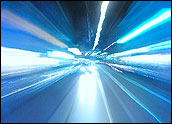
Advanced networking consortium Internet2 announced on Tuesday that an international team of researchers led by the University of Tokyo have set two new Internet2 Land Speed Records.
The achievement came over the course of two days during which university researchers added the new records to the eight others that other University of Tokyo-led teams had racked up previously.
“The University of Tokyo has been entering this contest for the past couple of years and they just keep outdoing themselves,” Lauren Rotman, an Internet2 spokesperson, told TechNewsWorld. “They hold the last 10 records for the land speed record. This is completely a University of Tokyo achievement.”
Surf’s Up
Created in 1996, Internet2 is a consortium of some 200 research universities, 70 corporations, 45 government agencies, 50 international organizations as well as other institutions.
Using a high-performance network infrastructure, Internet2 members, researchers and students are instrumental in the development of next-generation technologies including middleware, security, network research and performance measurement capabilities that are essential for the continued growth and expansion of the commercial Internet.
One technology upgrade Internet2 members have been testing is IPv6 (Internet protocol version 6), a network layer protocol for packet-switched Internet that is the successor to the current version of the widely used IPv4 Internet Protocol. The benefit of IPv6 is that it can support significantly more individual IP addresses for networked devices. For instance, each mobile phone and portable electronic device, numbering in the billions, could have its own IP address under IPv6.
IPv6 will offer 5×1028 addresses for each of the world’s 6.5 billion people. IPv4, on the other hand, only supports about 4.3 billion addresses.
While many Asian countries have already made the switch to IPv6, the U.S. government has set a 2008 deadline for all civilian and defense contractors to move to IPv6. According to Rotman, deployment of IPv6 depends on commercial enterprises.
Faster Than a Speeding Bullet
The first record, achieved on December 30, came after researchers successfully sent data at 7.67 gigabits per second (Gbps) over a next-generation IPv6 network path using standard TCP communications protocols. The team created a network path over 30,000 kilometers in distance that crossed six international networks and spanned more than three-quarters of the Earth’s circumference.
The record breaking data transmission rate of 7.67 Gbps was the equivalent to 230,100 terabit-meters per second (TB-m/s).
The following day, researchers, using a modified version of TCP, were able to surpass their earlier work to pull off an even faster record.
With the same 30,000 km path, researchers pushed the network to a throughput of 9.08 Gbps, equal to 272,400 Tb-m/s for both the IPv6 multi and single stream categories. By doing so, the team surpassed the current IPv4 records, proving that IPv6 networks are able to provide the same, if not better, performance as IPv4, Internet2 said.
“These records are final for the 10 GBps network era because they represent more than 98 percent of the upper limit of network capacity,” said Dr. Kei Hiraki, professor at the University of Tokyo and Land Speed Record team leader. “Through collaboration by a number of institutions, we have demonstrated the ability to overcome the distance and achieve this newest mark.”
Proving Performance
Each new land speed record demonstrates the ability to maximize the network and show the potential of existing networks and the technology, Rotman explained. The records also answer one big concern about IPv6 — whether it has the ability to provide the same levels of performance as IPv4.
“For this particular record, it’s significant because it shows that the performance of IPv6 is the same, if not better than IPv4,” she said.
“Land Speed Record contest is also significant, because it demonstrates the ability of research and education networks to reliably support ultra high-bandwidth applications,” Rotman concluded.




















































